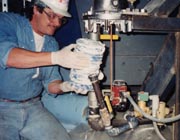Product Recovery Using Pigs

Process plants deal with the same directives any industry faces - maximizing production and minimizing costs. Every ounce of raw materials - as well as the final product - should end up in a container ready to be sold. The product left in the pipe after a production run has to be removed in preparation for another product transfer. To properly prepare the line for the next batch, operators will attempt to recover as much product as possible by draining the piping and then performing some type of cleaning, whether it be air blowing, flushing a cleaning solution through the system or transferring enough volume of the next product until cross-contamination is eliminated. Regardless of the technique used, waste effluents are generated that will require some sort of treatment or disposal. The more product left in a piping system, the more cleaning solution necessary to sufficiently clean a piping network.
As product recovery becomes more efficient, the volume of waste effluent will be reduced. One proven method to accomplish this goal is with a product recovery system that uses a device called a "pig". A pig can be best described as a cylindrical device propelled through a piece of pipe by differential pressure. The pig is slightly larger than the internal diameter of the pipe, exerting force against the pipe's surface to create a sealing, wiping effect.
Running a pig in a line can be compared to the system that carries checks and money from your car to the teller at a drive-thru bank. Pigging has been used in the oil and gas pipeline industry for nearly 100 years. Though not new to process plants, the interest in industrial pigging systems has increased as plants struggle to produce more sellable product while reducing the costs associated with treatment of waste effluent. Pigging systems have been used by plants manufacturing numerous products, from adhesives, sealants, paints, and ink to lube oils and food-grade products.
Product-Recovery Systems
Product DisplacementThe normal procedure used by plants to evacuate a line after a batch transfer is to drain as much of the material as possible and then use air or nitrogen to blow residual product from the pipe surface and low spots. This method is inefficient and can be time consuming. A product-recovery system, or PRS, can be used after a product transfer to displace and recover sellable residual product and clean the pipe wall, thus saving valuable product that would otherwise have been flushed to waste. Pigs are very efficient at pushing out fluids. The sealing capability of the pig maintains a barrier between the product and the propelling medium, and pushes the product through the outlet piping at the end of the line.
Waste Effluents
Under normal practices, an operator would be faced with running water, solvents or other cleaning solutions following a batch transfer to clean or sanitize a piping section before another product can be introduced. In some cases, the volume of a cleaning solution flush needed to properly clean the line is equal to many line volumes of the piping system. This can greatly increase the amount of effluent that a plant must consider when calculating the overall cost of their product. By maximizing product recovery using a pig, the amount of product left in the pipe is miniscule, greatly reducing not only the volume of cleaning solution needed but also the amount of waste that will need to be treated and disposed. In addition, the amount of time needed to sufficiently clean a piping system is greatly reduced.
Product Batching/Separation
In a perfect world, all process lines would be dedicated to a single product, thus requiring no batch separation or cleaning between batches. Realistically, this theory does not apply. Plants try to maximize use of existing piping facilities by transporting numerous products between blending and packaging equipment. When a single piping run is used for several similar family-grouped products, a cleaning cycle must be used between each product. A pigging system can be set up to evacuate the first product and avoid contamination with the next by running a pig between the two materials.

In its simplest form, a pigging system consists of two fittings on each end of the piping run. A launcher is placed at the beginning of the line and a receiver at the end. These fittings consist of a slightly oversized barrel, a quick-opening closure and lateral branches for inlet/outlet of product, vents, etc. The pig generally used is a solid-molded device made from either urethane or a rubber compound with multiple circular discs that both seal and wipe against the internal surface of the pipe. It is flexible enough to negotiate bends, yet it seals well enough to ensure virtually no bypass. Pigs move through the pipe by the differential pressure of the propelling medium, such as air, nitrogen, water or solvents.
Pigging systems can be unidirectional or bidirectional. On a unidirectional application, the pig is removed from the receiver following a run from launching to receiving end. A bidirectional system allows the pig to return to the launching end to wait until another run is needed. The pig stays in the line at all times, being stored out of the product flow at either end of the piping run. This gives the operator control over the movement of the pig without the need to depressurize and open the line to the atmosphere. To help keep track of the pig's location, a magnet is molded in the pig. External, non-intrusive sensors register the magnetic field and send a signal to a computer control system where it can be integrated with the operation of valves, pumps, etc. The entire procedure of product transfer and line cleaning can be done automatically by controlling the movement of the pig.

For more information on pigging, phone (713) 973-0079 or (888) 973-0079; fax (713) 973-6614; e-mail glsmith@inlineplc.com ; or visit http://www.inlineplc.com .
Looking for a reprint of this article?
From high-res PDFs to custom plaques, order your copy today!



